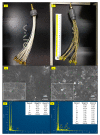Exploring Nanosilver-Coated Hollow Fiber Microfiltration to Mitigate Biofouling for High Loading Membrane Bioreactor
- PMID: 31242707
- PMCID: PMC6631756
- DOI: 10.3390/molecules24122345
Exploring Nanosilver-Coated Hollow Fiber Microfiltration to Mitigate Biofouling for High Loading Membrane Bioreactor
Abstract
For the first time, a nanosilver-coated hollow fiber microfiltration (MF) was fabricated by a simple chemical reduction method, then tested for membrane biofouling mitigation study under extreme high mixed liquor suspended solid (MLSS) concentration for long term. This study presents a simple and novel technique to modify a commercially available MF membrane using silver nanoparticles (AgNPs) followed by an investigation of mitigating membrane biofouling potentials using this modified membrane to compare with an unmodified membrane for 60-day operation period. The modified membranes showed that AgNPs was attached to the MF-membrane successfully with a high density of 119.85 ± 5.42 mg/m2. After long-term testing of 60 days in membrane bioreactor with a MLSS concentration of 11,000 mg/L, specific flux of the AgNPs coated MF (AgNPs-MF) decreased 59.7%, while the specific flux of the unmodified membrane dropped 81.8%, resulted from the increase of transmembrane vacuum pressure for the AgNPs-MF was lower than that of the unmodified one. The resistance-in-series model was used to calculate the resistance coefficients of membrane modules, and the result showed that the cake layer resistance coefficient of the unmodified membrane was 2.7 times higher than that of the AgNPs-MF after the 60-day operation, confirming that AgNPs displayed great antimicrobial properties to mitigate membrane biofouling under such high MLSS.
Keywords: membrane biofouling mitigation/control; membrane modification; microfiltration membrane bioreactor; silver nanoparticles.
Conflict of interest statement
The authors declare no conflict of interest.
Figures









References
-
- Radjenović J., Matošić M., Mijatović I., Petrović M., Barceló D. Membrane Bioreactor (MBR) as an Advanced Wastewater Treatment Technology. In: Barceló D., Petrovic M., editors. Emerging Contaminants from Industrial and Municipal Waste: Removal Technologies. Springer; Berlin/Heidelberg, Germany: 2008. pp. 37–101.
-
- Bagheri M., Mirbagheri S.A., Kamarkhani A.M., Bagheri Z. Modeling of effluent quality parameters in a submerged membrane bioreactor with simultaneous upward and downward aeration treating municipal wastewater using hybrid models. Desalin. Water Treat. 2016;57:8068–8089. doi: 10.1080/19443994.2015.1021852. - DOI
MeSH terms
Substances
LinkOut - more resources
Full Text Sources

